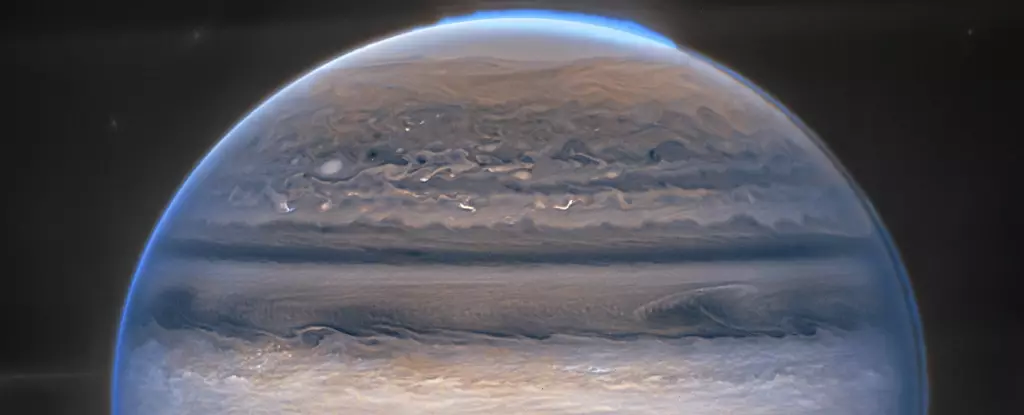Jupiter, the gargantuan fifth planet from the Sun, stands out as a cosmic curiosity in our solar system. Unlike Earth, which boasts solid ground and familiar landscapes, Jupiter presents a strikingly different reality—there is no surface to walk upon. This article delves into the complexities of what makes Jupiter unique, its mysterious composition, and its significant role within our cosmic neighborhood.
To encapsulate Jupiter’s essence, one must grasp the category of gas giants. Unlike the terrestrial planets—Mercury, Venus, Earth, and Mars—that are composed of solid rock and metal, Jupiter is predominantly a swirling mass of gases, mainly hydrogen and helium. The absence of a solid surface implies that a spacecraft cannot simply land on Jupiter as it could on Earth or Mars. Instead, the planet is composed of layers that undergo continuous transitions, culminating in an ever-increasing pressure as one descends.
This continuous layering presents an intriguing yet alien experience. As one ventures deeper into the atmosphere, pressures intensify massively, akin to plunging into the deepest depths of Earth’s oceans, but with the environment consisting of gas rather than water. When considering these depths, it’s astonishing to realize that pressures sufficient to crush the human body are achieved just a few hundred miles down.
At about 1,000 miles beneath Jupiter’s upper atmospheric layers, one encounters a dramatic transformation in the behavior of hydrogen. It transitions into liquid hydrogen, forming what can be envisioned as the universe’s largest ocean—but devoid of its conventional aqueous nature. Continuing downward, this liquid hydrogen evolves into a more exotic state known as metallic hydrogen. It’s here that the electrons become decoupled from their respective nuclei, leading to a highly conductive and fluid-like state never before replicated on Earth, except under extreme experimental conditions.
The transitions in state from gaseous to liquid and finally to metallic hydrogen are not abrupt. Instead, they reveal a gradual metamorphosis as one delves deeper into the planet’s mysteries. This seamless continuity is a stark contrast to the rigid delineations of solid surfaces found on rocky planets, raising profound questions about the mechanics that nourish such planetary structures.
Beneath Jupiter’s thick gases lies its core, a concept that remains nebulous in the scientific community. Current prevailing theories suggest that this core may not be solid, per se, but exists as a hot, dense mixture possibly containing both liquid and solid states of material. The conditions at Jupiter’s core are analogous to being subjected to pressures reaching 100 million times that of Earth’s atmosphere. Such extremes pose insurmountable challenges for exploration, primarily due to the overwhelming heat of around 35,000 degrees Fahrenheit. This temperature exceeds that of the Sun’s surface thrice over, presenting daunting barriers to data collection.
As fascinating as Jupiter appears, its sheer inhospitableness makes it an unlikely candidate for sustaining life as we know it. Yet, understanding these conditions and the planetary dynamics involved not only enlightens our knowledge of Jupiter itself, but it could also shed light on the formation and evolution of other celestial bodies.
Despite its prohibitive conditions, Jupiter’s presence exerts a significant influence on the solar system. Acting as a cosmic shield, its massive gravitational field assists in redirecting potentially hazardous asteroids and comets that might otherwise collide with Earth and the inner planets. Throughout cosmic history, Jupiter has played a critical role in minimizing impacts with these celestial bodies that could trigger catastrophic extinction events. The very existence of such a magnificent gas giant may have indirectly allowed for the flourishing of life on Earth.
While Jupiter itself is a forbidding frontier, its moons, particularly Europa, offer tantalizing prospects for finding extraterrestrial life. Europa is enveloped in an icy crust thought to conceal a vast sub-surface ocean, raising the tantalizing possibility of life lurking beneath its frozen exterior. NASA’s Europa Clipper mission, scheduled for launch in October 2024, aims to explore this moon comprehensively and may broaden our understanding of where life could thrive beyond our planet.
The vastness of Jupiter encompasses extraordinary characteristics that challenge our traditional perceptions of planetary structures. This gas giant portrays an intricate world devoid of a solid surface, maintaining a dynamic environment governed by extreme temperatures and pressures. As science and technology advance, our opportunity to explore and comprehend Jupiter and her moons further increases, prompting us to reconsider what life might look like elsewhere in our solar system and beyond. Jupiter’s complexity continues to fascinate scientists and enthusiasts alike, standing as a testament to the endless wonders of the cosmos.


Leave a Reply